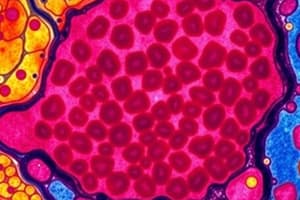Podcast
Questions and Answers
What is the primary function of epithelial tissue?
What is the primary function of epithelial tissue?
- To protect, absorb, secrete, and sense (correct)
- To provide support and structure to the body
- To regulate body temperature and maintain posture
- To transmit and process information
Which type of tissue is responsible for transmitting and processing information?
Which type of tissue is responsible for transmitting and processing information?
- Nervous tissue (correct)
- Connective tissue
- Epithelial tissue
- Muscle tissue
What is the function of the plasma membrane?
What is the function of the plasma membrane?
- To control body functions
- To perform metabolic processes
- To regulate body temperature
- To separate the cell from its environment (correct)
What is the process of adding color to tissues and cells to enhance visibility under a microscope?
What is the process of adding color to tissues and cells to enhance visibility under a microscope?
What is the primary function of connective tissue?
What is the primary function of connective tissue?
What is the function of the nucleus?
What is the function of the nucleus?
What is the process of preserving tissues and cells to prevent degradation?
What is the process of preserving tissues and cells to prevent degradation?
What is the purpose of embedding in histological techniques?
What is the purpose of embedding in histological techniques?
Study Notes
Definition and Scope
- Histology is the study of the microscopic structure of tissues and cells.
- It is a branch of biology that deals with the examination of tissues and cells in relation to their function and behavior.
Tissue Types
- Epithelial tissue: forms the lining of organs, glands, and other body surfaces.
- Functions: protection, absorption, secretion, and sensation.
- Connective tissue: provides support, structure, and connectivity to the body.
- Functions: binding, supporting, and protecting organs and tissues.
- Muscle tissue: responsible for movement and contraction.
- Functions: voluntary and involuntary movement, maintenance of posture, and regulation of body temperature.
- Nervous tissue: responsible for transmitting and processing information.
- Functions: transmission of nerve impulses, control of body functions, and interpretation of sensory information.
Cell Components
- Plasma membrane: the outermost layer of the cell, separating the cell from its environment.
- Cytoplasm: the jelly-like substance inside the cell, where metabolic processes occur.
- Nucleus: the control center of the cell, containing genetic material.
- Organelles: specialized structures within the cell, performing specific functions.
- Examples: mitochondria, endoplasmic reticulum, ribosomes, and lysosomes.
Staining and Microscopy
- Staining: a process of adding color to tissues and cells to enhance visibility under a microscope.
- Microscopy: the use of microscopes to examine tissues and cells.
- Types: light microscopy, electron microscopy, and fluorescence microscopy.
Histological Techniques
- Fixation: the process of preserving tissues and cells to prevent degradation.
- Dehydration: the removal of water from tissues and cells to prepare for sectioning.
- Embedding: the process of surrounding tissues and cells with a supporting material for sectioning.
- Sectioning: the process of cutting tissues and cells into thin slices for examination.
- Mounting: the process of attaching tissues and cells to a microscope slide for examination.
Definition and Scope
- Histology is the study of the microscopic structure of tissues and cells.
- It is a branch of biology that deals with the examination of tissues and cells in relation to their function and behavior.
Tissue Types
- Epithelial tissue forms the lining of organs, glands, and other body surfaces, and functions in protection, absorption, secretion, and sensation.
- Connective tissue provides support, structure, and connectivity to the body, and functions in binding, supporting, and protecting organs and tissues.
- Muscle tissue is responsible for movement and contraction, and functions in voluntary and involuntary movement, maintenance of posture, and regulation of body temperature.
- Nervous tissue is responsible for transmitting and processing information, and functions in transmission of nerve impulses, control of body functions, and interpretation of sensory information.
Cell Components
- The plasma membrane is the outermost layer of the cell, separating the cell from its environment.
- Cytoplasm is the jelly-like substance inside the cell, where metabolic processes occur.
- The nucleus is the control center of the cell, containing genetic material.
- Organelles are specialized structures within the cell, performing specific functions, such as mitochondria, endoplasmic reticulum, ribosomes, and lysosomes.
Staining and Microscopy
- Staining is a process of adding color to tissues and cells to enhance visibility under a microscope.
- Microscopy is the use of microscopes to examine tissues and cells, and includes types such as light microscopy, electron microscopy, and fluorescence microscopy.
Histological Techniques
- Fixation is the process of preserving tissues and cells to prevent degradation.
- Dehydration is the removal of water from tissues and cells to prepare for sectioning.
- Embedding is the process of surrounding tissues and cells with a supporting material for sectioning.
- Sectioning is the process of cutting tissues and cells into thin slices for examination.
- Mounting is the process of attaching tissues and cells to a microscope slide for examination.
Studying That Suits You
Use AI to generate personalized quizzes and flashcards to suit your learning preferences.
Description
Explore the basics of histology, including the study of microscopic tissue structure, epithelial and connective tissues, and their functions in the human body.




